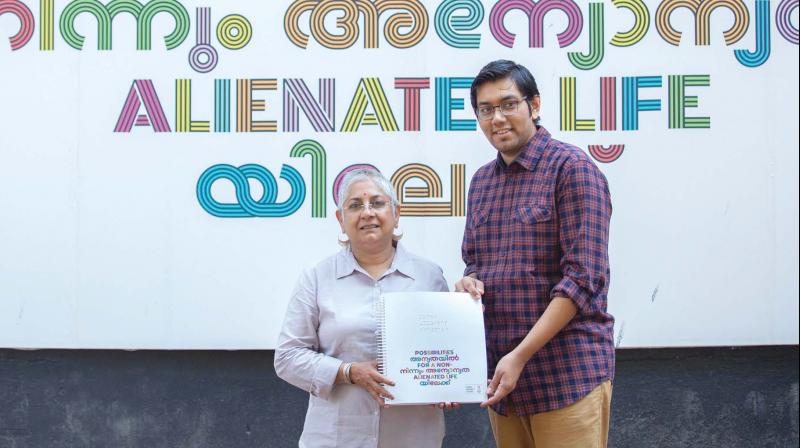Biennale includes braille text

Into its final fortnight, the fourth edition of the Kochi-Muziris Biennale (KMB) has acquired one more feature that highlights inclusivity: Braille text.
Tactility became even more pronounced at the ongoing 108-day art festival, as 25 open Braille books have been created to the benefit of the visitors at each of the ten venues. Supported by the DAG, the facility installed on Saturday can be accessed on demand till the show concludes on March 29.
“The whole idea of this biennale is inclusion and we are happy to be out with the Braille guide,” says curator Anita Dube, about the touch-and-read system for the visually-impaired. “It is very important to make art accessible.”
The launch of the facility on Saturday also marked the start of a week-long workshop aiming to sensitise people that disability of any form should not stop anyone from enjoying art. As Kochi Biennale Foundation (KBF) president Bose Krishnamachari notes, sensitisation is the key to build a more inclusive world. “The idea of this workshop is to spread as much awareness about it as possible.” The Braille guide is ‘just the beginning’, according to Bose. “We also have some artists’ work in tactile form at the biennale. For the next edition, we aim to have Braille guide from the opening day. And tactile artwork wherever feasible,” he adds.
The current edition that began on December 12 last year has five tactile works and a tactile map. The work includes two of Cyrus Kabiru and Priya Ravish Mehra each and one set of 10 tactile soft toys based on the work of artist Madhvi Parekh.
As for the inclusive workshop, the first leg titled ‘Blindfold Art Sensitisation’ was conducted by Siddhant Shah, an accessibility consultant. The entire series at the art room in Cabral Yard venue of Fort Kochi focuses on the idea of increasing access to art for people with various types of disabilities.
“Inclusivity is the key to inspire people with different special needs. We need to open spaces in our society for everyone,” says 28-year-old Siddhant, who runs an initiative called ‘Access for All’ that strives to bridge the gap between cultural heritage and disability. “There will also be workshops to sensitisation of the general public towards people with special needs.”
The upcoming week will also host the last leg of Paris-based Thomas Hirschhorn’s month-long workshop Energy: Yes! Quality: No!. On Sunday, Rangashree group presented a theatre performance at the Biennale Pavilion. On Monday and Tuesday (March 18 and 19), the venue will have music shows by band Threshold and musician Binu Koshy respectively. There will also be a book reading session by author Ajit Mani The Nawab’s Tears on March 19.
On March 21 and 22, the KBF will convene the third Students’ Biennale Education Conference in association with the Delhi-based Foundation for Indian Contemporary Art. Titled Pedagogical In-Flux and the Art of Education, the conference features panel discussions on subjects like the potential of localised forms of learning and technologies of arts and material reality within contemporary practice. The sessions aim to provide an overview of the Students’ Biennale Education platforms at art college students across India, address questions about the present state of education and allow formation of frameworks in teaching. Scholars and experts from across the world will speak on matters such as learner-centric pedagogy, technologies of teaching, new materialism and significance of locations/sites in artistic practices.
The last week will have Artists’ Cinema package screening titled Cinema of Resistance curated by filmmaker Sandeep Chatterjee. Simultaneously, there will be a workshop on gender sensitisation and ephemeral flora at the art room. Titled Queer Life Drawing, it will examine and deconstruct gender stereotypes. Conducted by Scotland-based Tilly Gifford who identifies oneself as queer, the workshop will facilitate drawing activities whilst playfully questioning gender identities.

